Sustainable Energy Sources: Poland's Renewable Energy Transition
VerifiedAdded on 2022/10/04
|18
|4350
|17
Report
AI Summary
This research paper provides a comprehensive overview of renewable energy in Poland, exploring the country's transition from a coal-dependent energy system to one that incorporates sustainable sources. It examines the current energy mix, with a focus on wind, solar, and biomass, while also analyzing the challenges and opportunities associated with integrating these renewable sources. The paper highlights the role of government policies, economic factors, and technological advancements in shaping Poland's renewable energy market. It delves into the potential of various renewable sources, including the impact of wind farms and solar PV installations, as well as the role of biomass. The report also addresses the country's efforts to meet European climate targets, reduce carbon emissions, and ensure energy security through the adoption of renewable energy technologies. It further discusses the investment incentives and regulations that promote renewable energy development in Poland, including the renewable energy act, and the impact of these on the energy sector. The report concludes by assessing the future prospects for renewable energy in Poland, considering the country's potential to increase the share of renewable energy in its energy mix and its contribution to a sustainable energy future.
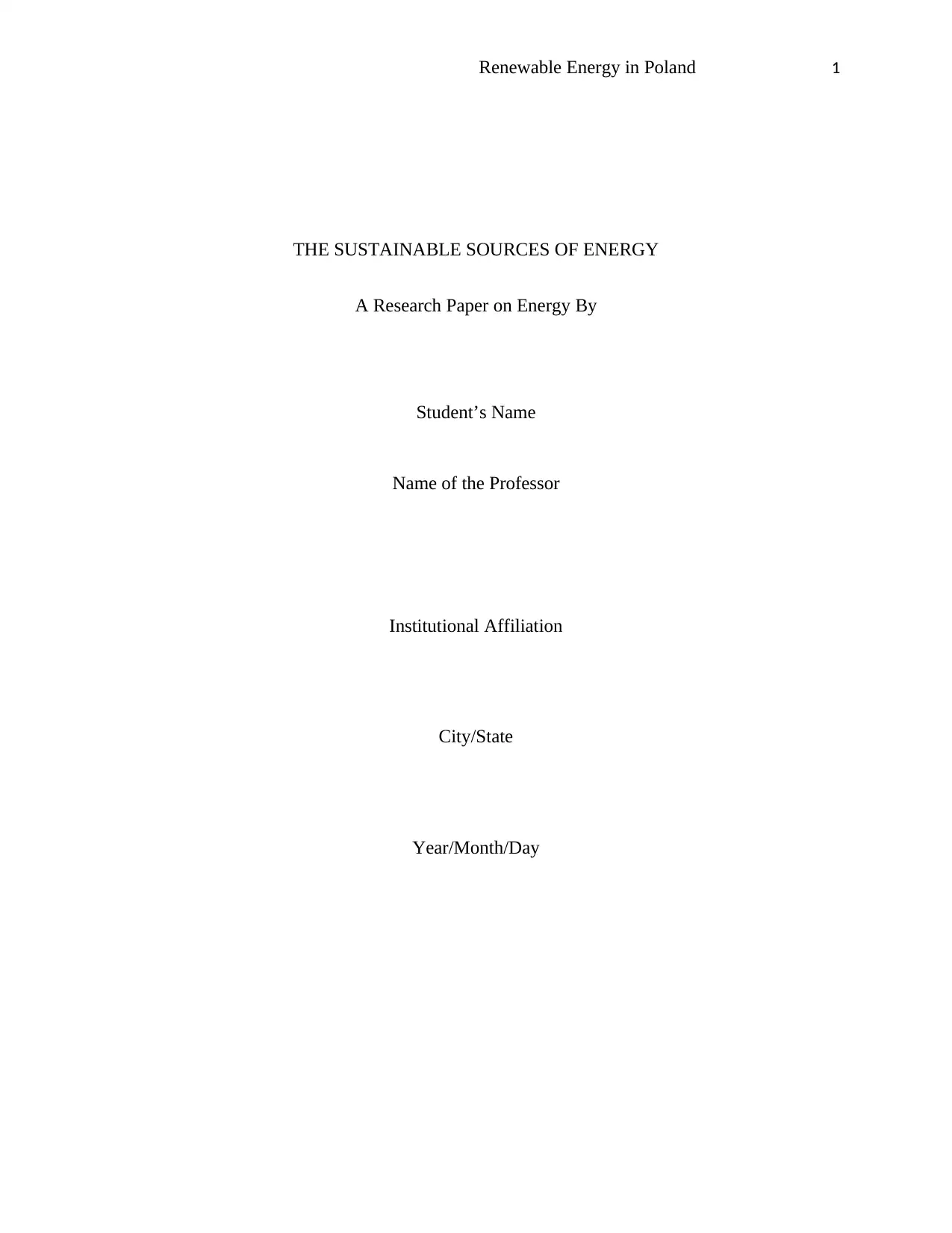
Renewable Energy in Poland 1
THE SUSTAINABLE SOURCES OF ENERGY
A Research Paper on Energy By
Student’s Name
Name of the Professor
Institutional Affiliation
City/State
Year/Month/Day
THE SUSTAINABLE SOURCES OF ENERGY
A Research Paper on Energy By
Student’s Name
Name of the Professor
Institutional Affiliation
City/State
Year/Month/Day
Paraphrase This Document
Need a fresh take? Get an instant paraphrase of this document with our AI Paraphraser
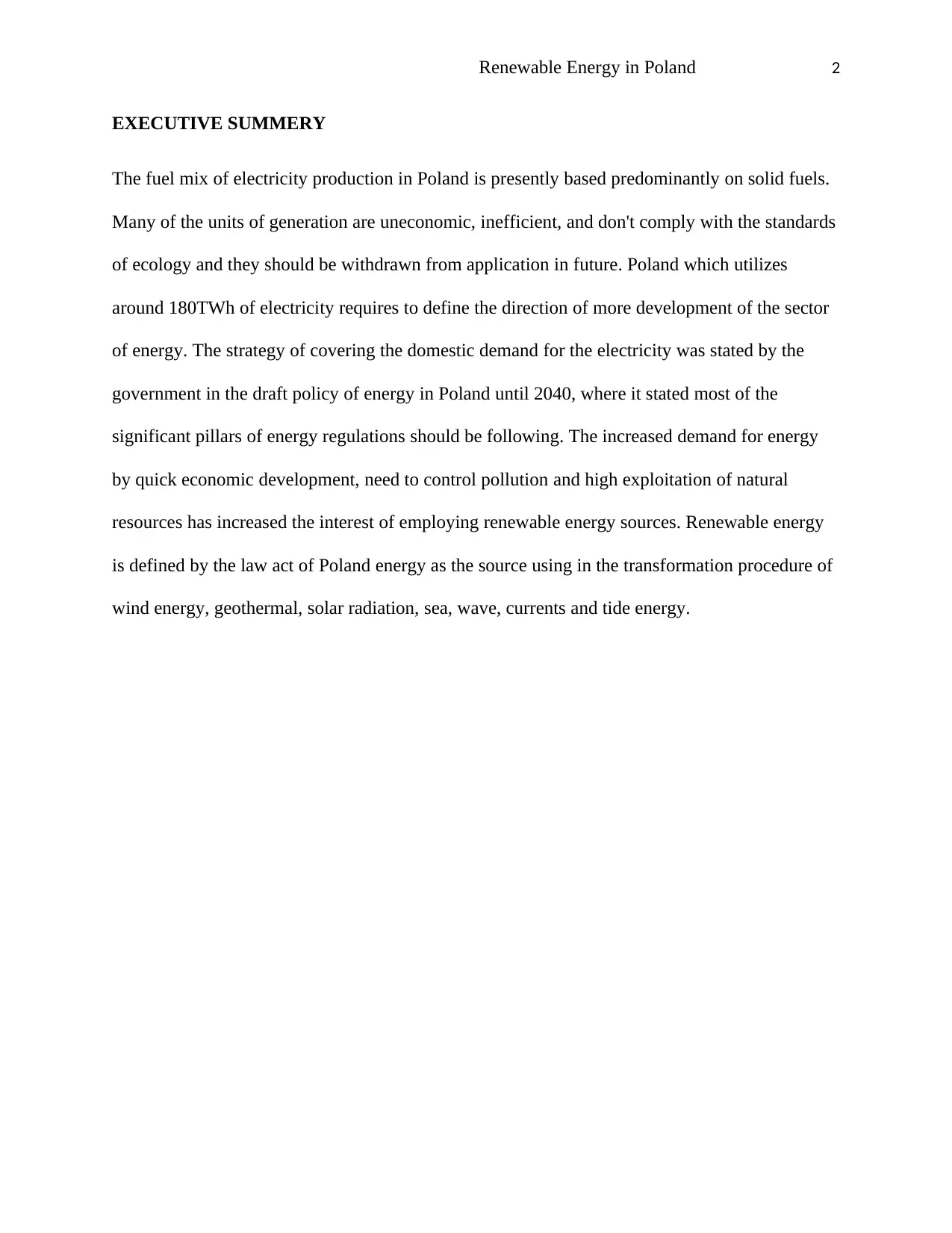
Renewable Energy in Poland 2
EXECUTIVE SUMMERY
The fuel mix of electricity production in Poland is presently based predominantly on solid fuels.
Many of the units of generation are uneconomic, inefficient, and don't comply with the standards
of ecology and they should be withdrawn from application in future. Poland which utilizes
around 180TWh of electricity requires to define the direction of more development of the sector
of energy. The strategy of covering the domestic demand for the electricity was stated by the
government in the draft policy of energy in Poland until 2040, where it stated most of the
significant pillars of energy regulations should be following. The increased demand for energy
by quick economic development, need to control pollution and high exploitation of natural
resources has increased the interest of employing renewable energy sources. Renewable energy
is defined by the law act of Poland energy as the source using in the transformation procedure of
wind energy, geothermal, solar radiation, sea, wave, currents and tide energy.
EXECUTIVE SUMMERY
The fuel mix of electricity production in Poland is presently based predominantly on solid fuels.
Many of the units of generation are uneconomic, inefficient, and don't comply with the standards
of ecology and they should be withdrawn from application in future. Poland which utilizes
around 180TWh of electricity requires to define the direction of more development of the sector
of energy. The strategy of covering the domestic demand for the electricity was stated by the
government in the draft policy of energy in Poland until 2040, where it stated most of the
significant pillars of energy regulations should be following. The increased demand for energy
by quick economic development, need to control pollution and high exploitation of natural
resources has increased the interest of employing renewable energy sources. Renewable energy
is defined by the law act of Poland energy as the source using in the transformation procedure of
wind energy, geothermal, solar radiation, sea, wave, currents and tide energy.
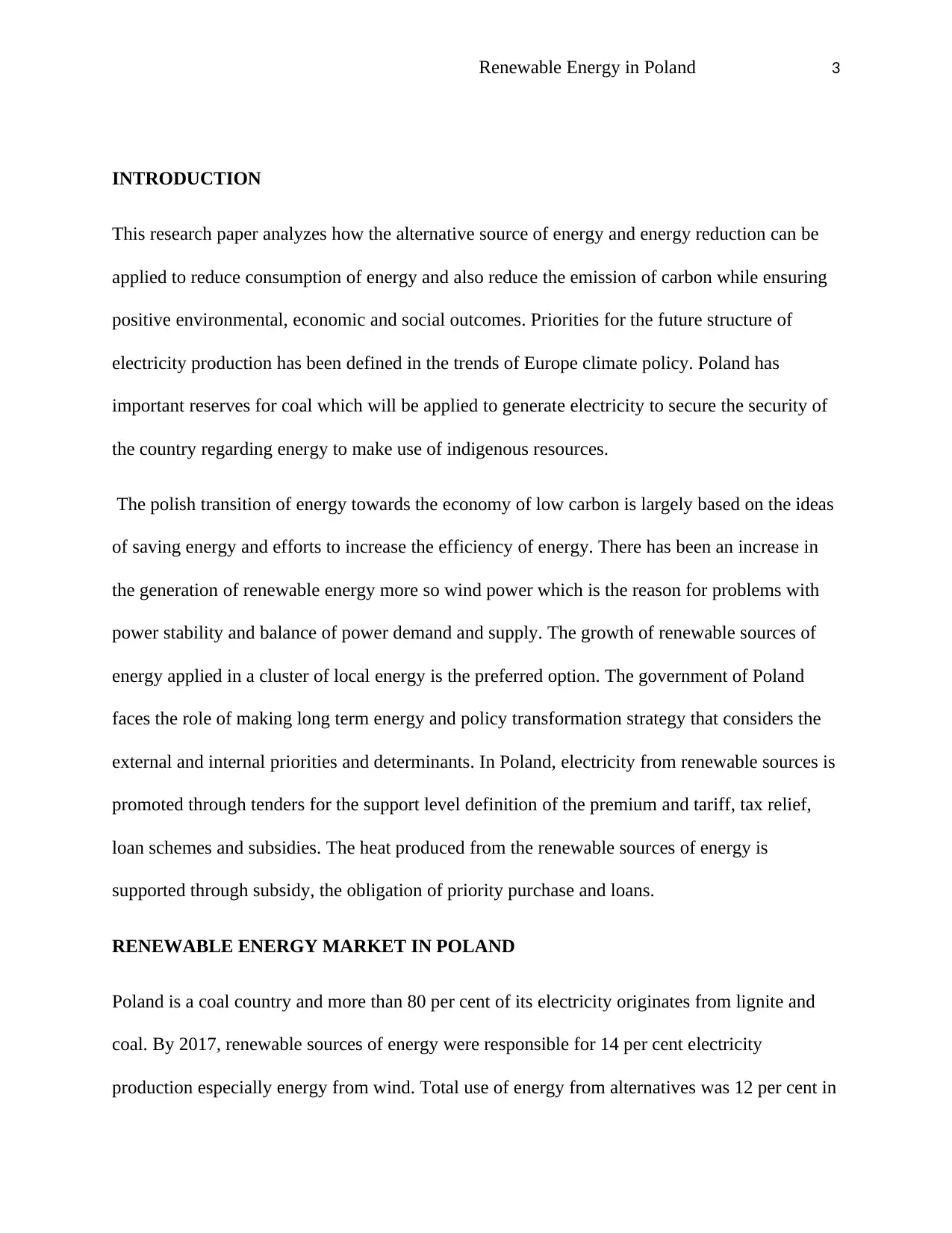
Renewable Energy in Poland 3
INTRODUCTION
This research paper analyzes how the alternative source of energy and energy reduction can be
applied to reduce consumption of energy and also reduce the emission of carbon while ensuring
positive environmental, economic and social outcomes. Priorities for the future structure of
electricity production has been defined in the trends of Europe climate policy. Poland has
important reserves for coal which will be applied to generate electricity to secure the security of
the country regarding energy to make use of indigenous resources.
The polish transition of energy towards the economy of low carbon is largely based on the ideas
of saving energy and efforts to increase the efficiency of energy. There has been an increase in
the generation of renewable energy more so wind power which is the reason for problems with
power stability and balance of power demand and supply. The growth of renewable sources of
energy applied in a cluster of local energy is the preferred option. The government of Poland
faces the role of making long term energy and policy transformation strategy that considers the
external and internal priorities and determinants. In Poland, electricity from renewable sources is
promoted through tenders for the support level definition of the premium and tariff, tax relief,
loan schemes and subsidies. The heat produced from the renewable sources of energy is
supported through subsidy, the obligation of priority purchase and loans.
RENEWABLE ENERGY MARKET IN POLAND
Poland is a coal country and more than 80 per cent of its electricity originates from lignite and
coal. By 2017, renewable sources of energy were responsible for 14 per cent electricity
production especially energy from wind. Total use of energy from alternatives was 12 per cent in
INTRODUCTION
This research paper analyzes how the alternative source of energy and energy reduction can be
applied to reduce consumption of energy and also reduce the emission of carbon while ensuring
positive environmental, economic and social outcomes. Priorities for the future structure of
electricity production has been defined in the trends of Europe climate policy. Poland has
important reserves for coal which will be applied to generate electricity to secure the security of
the country regarding energy to make use of indigenous resources.
The polish transition of energy towards the economy of low carbon is largely based on the ideas
of saving energy and efforts to increase the efficiency of energy. There has been an increase in
the generation of renewable energy more so wind power which is the reason for problems with
power stability and balance of power demand and supply. The growth of renewable sources of
energy applied in a cluster of local energy is the preferred option. The government of Poland
faces the role of making long term energy and policy transformation strategy that considers the
external and internal priorities and determinants. In Poland, electricity from renewable sources is
promoted through tenders for the support level definition of the premium and tariff, tax relief,
loan schemes and subsidies. The heat produced from the renewable sources of energy is
supported through subsidy, the obligation of priority purchase and loans.
RENEWABLE ENERGY MARKET IN POLAND
Poland is a coal country and more than 80 per cent of its electricity originates from lignite and
coal. By 2017, renewable sources of energy were responsible for 14 per cent electricity
production especially energy from wind. Total use of energy from alternatives was 12 per cent in
⊘ This is a preview!⊘
Do you want full access?
Subscribe today to unlock all pages.

Trusted by 1+ million students worldwide
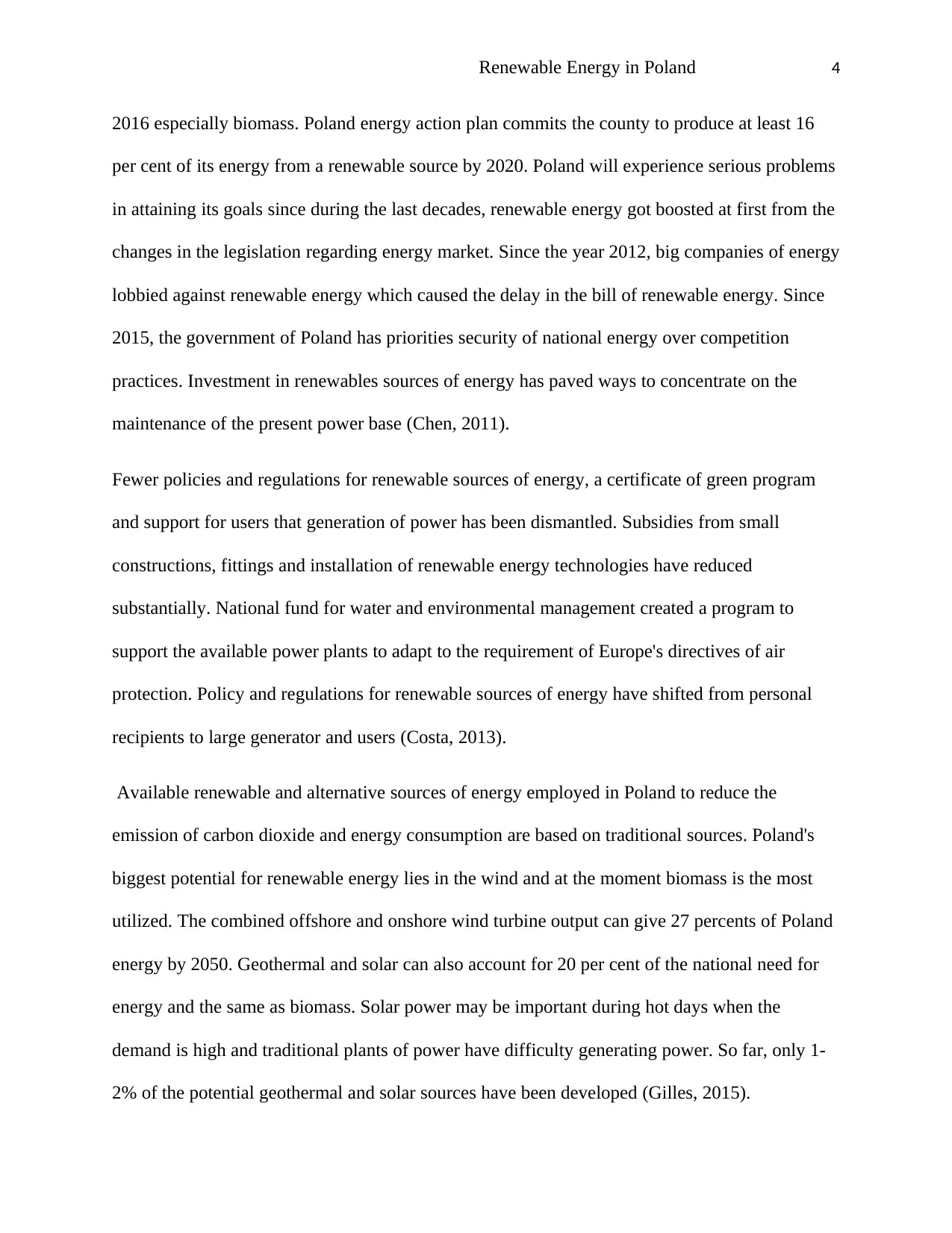
Renewable Energy in Poland 4
2016 especially biomass. Poland energy action plan commits the county to produce at least 16
per cent of its energy from a renewable source by 2020. Poland will experience serious problems
in attaining its goals since during the last decades, renewable energy got boosted at first from the
changes in the legislation regarding energy market. Since the year 2012, big companies of energy
lobbied against renewable energy which caused the delay in the bill of renewable energy. Since
2015, the government of Poland has priorities security of national energy over competition
practices. Investment in renewables sources of energy has paved ways to concentrate on the
maintenance of the present power base (Chen, 2011).
Fewer policies and regulations for renewable sources of energy, a certificate of green program
and support for users that generation of power has been dismantled. Subsidies from small
constructions, fittings and installation of renewable energy technologies have reduced
substantially. National fund for water and environmental management created a program to
support the available power plants to adapt to the requirement of Europe's directives of air
protection. Policy and regulations for renewable sources of energy have shifted from personal
recipients to large generator and users (Costa, 2013).
Available renewable and alternative sources of energy employed in Poland to reduce the
emission of carbon dioxide and energy consumption are based on traditional sources. Poland's
biggest potential for renewable energy lies in the wind and at the moment biomass is the most
utilized. The combined offshore and onshore wind turbine output can give 27 percents of Poland
energy by 2050. Geothermal and solar can also account for 20 per cent of the national need for
energy and the same as biomass. Solar power may be important during hot days when the
demand is high and traditional plants of power have difficulty generating power. So far, only 1-
2% of the potential geothermal and solar sources have been developed (Gilles, 2015).
2016 especially biomass. Poland energy action plan commits the county to produce at least 16
per cent of its energy from a renewable source by 2020. Poland will experience serious problems
in attaining its goals since during the last decades, renewable energy got boosted at first from the
changes in the legislation regarding energy market. Since the year 2012, big companies of energy
lobbied against renewable energy which caused the delay in the bill of renewable energy. Since
2015, the government of Poland has priorities security of national energy over competition
practices. Investment in renewables sources of energy has paved ways to concentrate on the
maintenance of the present power base (Chen, 2011).
Fewer policies and regulations for renewable sources of energy, a certificate of green program
and support for users that generation of power has been dismantled. Subsidies from small
constructions, fittings and installation of renewable energy technologies have reduced
substantially. National fund for water and environmental management created a program to
support the available power plants to adapt to the requirement of Europe's directives of air
protection. Policy and regulations for renewable sources of energy have shifted from personal
recipients to large generator and users (Costa, 2013).
Available renewable and alternative sources of energy employed in Poland to reduce the
emission of carbon dioxide and energy consumption are based on traditional sources. Poland's
biggest potential for renewable energy lies in the wind and at the moment biomass is the most
utilized. The combined offshore and onshore wind turbine output can give 27 percents of Poland
energy by 2050. Geothermal and solar can also account for 20 per cent of the national need for
energy and the same as biomass. Solar power may be important during hot days when the
demand is high and traditional plants of power have difficulty generating power. So far, only 1-
2% of the potential geothermal and solar sources have been developed (Gilles, 2015).
Paraphrase This Document
Need a fresh take? Get an instant paraphrase of this document with our AI Paraphraser
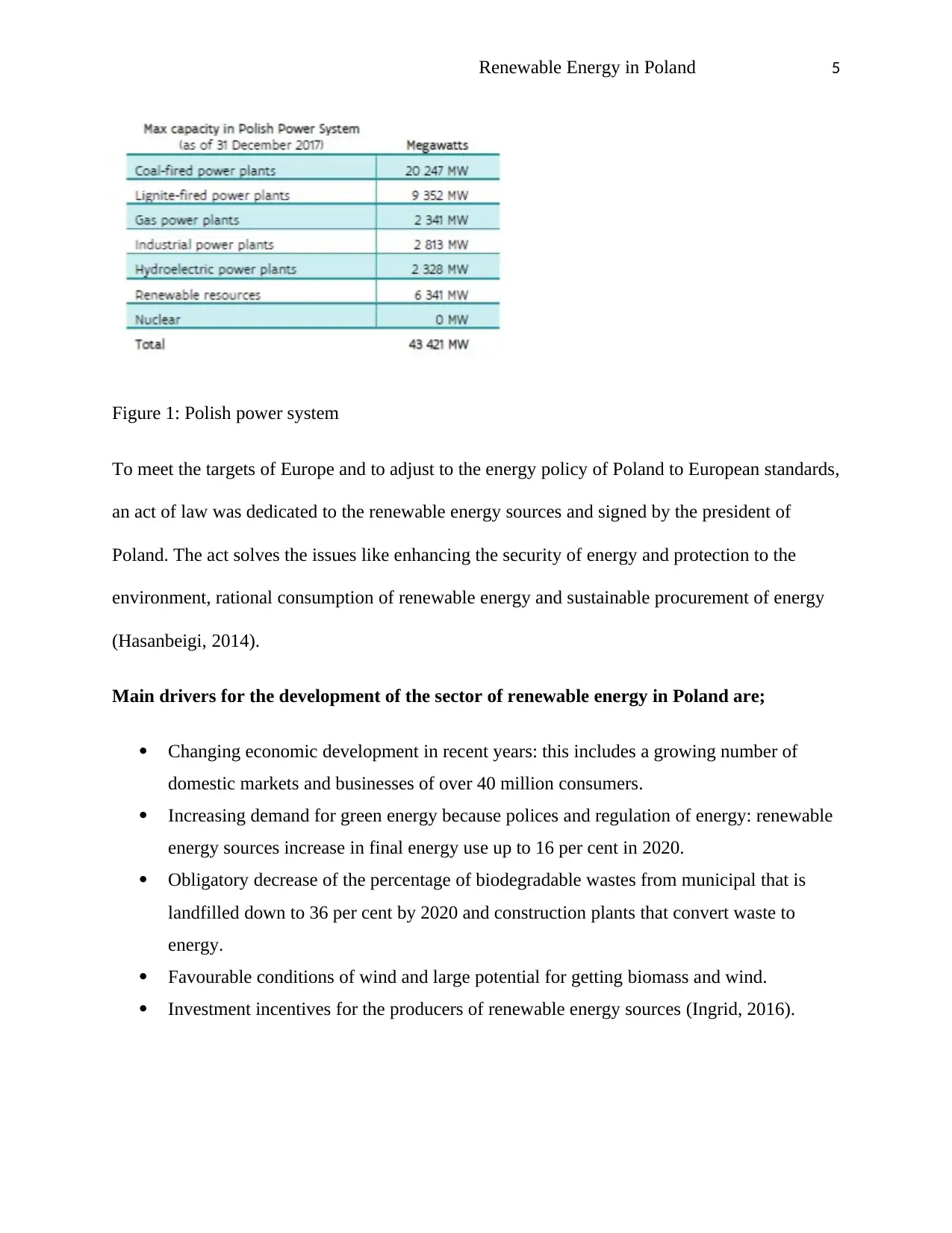
Renewable Energy in Poland 5
Figure 1: Polish power system
To meet the targets of Europe and to adjust to the energy policy of Poland to European standards,
an act of law was dedicated to the renewable energy sources and signed by the president of
Poland. The act solves the issues like enhancing the security of energy and protection to the
environment, rational consumption of renewable energy and sustainable procurement of energy
(Hasanbeigi, 2014).
Main drivers for the development of the sector of renewable energy in Poland are;
Changing economic development in recent years: this includes a growing number of
domestic markets and businesses of over 40 million consumers.
Increasing demand for green energy because polices and regulation of energy: renewable
energy sources increase in final energy use up to 16 per cent in 2020.
Obligatory decrease of the percentage of biodegradable wastes from municipal that is
landfilled down to 36 per cent by 2020 and construction plants that convert waste to
energy.
Favourable conditions of wind and large potential for getting biomass and wind.
Investment incentives for the producers of renewable energy sources (Ingrid, 2016).
Figure 1: Polish power system
To meet the targets of Europe and to adjust to the energy policy of Poland to European standards,
an act of law was dedicated to the renewable energy sources and signed by the president of
Poland. The act solves the issues like enhancing the security of energy and protection to the
environment, rational consumption of renewable energy and sustainable procurement of energy
(Hasanbeigi, 2014).
Main drivers for the development of the sector of renewable energy in Poland are;
Changing economic development in recent years: this includes a growing number of
domestic markets and businesses of over 40 million consumers.
Increasing demand for green energy because polices and regulation of energy: renewable
energy sources increase in final energy use up to 16 per cent in 2020.
Obligatory decrease of the percentage of biodegradable wastes from municipal that is
landfilled down to 36 per cent by 2020 and construction plants that convert waste to
energy.
Favourable conditions of wind and large potential for getting biomass and wind.
Investment incentives for the producers of renewable energy sources (Ingrid, 2016).
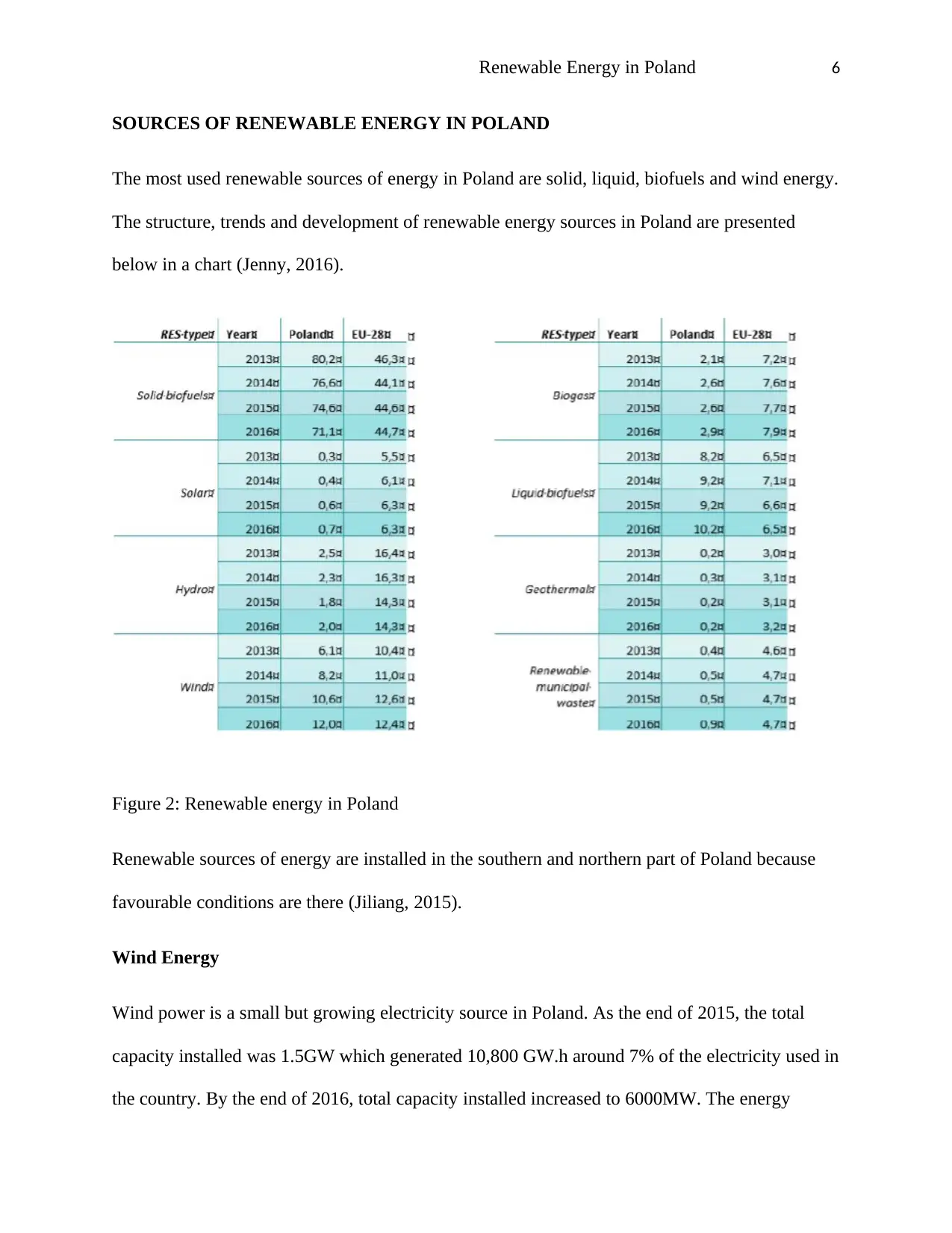
Renewable Energy in Poland 6
SOURCES OF RENEWABLE ENERGY IN POLAND
The most used renewable sources of energy in Poland are solid, liquid, biofuels and wind energy.
The structure, trends and development of renewable energy sources in Poland are presented
below in a chart (Jenny, 2016).
Figure 2: Renewable energy in Poland
Renewable sources of energy are installed in the southern and northern part of Poland because
favourable conditions are there (Jiliang, 2015).
Wind Energy
Wind power is a small but growing electricity source in Poland. As the end of 2015, the total
capacity installed was 1.5GW which generated 10,800 GW.h around 7% of the electricity used in
the country. By the end of 2016, total capacity installed increased to 6000MW. The energy
SOURCES OF RENEWABLE ENERGY IN POLAND
The most used renewable sources of energy in Poland are solid, liquid, biofuels and wind energy.
The structure, trends and development of renewable energy sources in Poland are presented
below in a chart (Jenny, 2016).
Figure 2: Renewable energy in Poland
Renewable sources of energy are installed in the southern and northern part of Poland because
favourable conditions are there (Jiliang, 2015).
Wind Energy
Wind power is a small but growing electricity source in Poland. As the end of 2015, the total
capacity installed was 1.5GW which generated 10,800 GW.h around 7% of the electricity used in
the country. By the end of 2016, total capacity installed increased to 6000MW. The energy
⊘ This is a preview!⊘
Do you want full access?
Subscribe today to unlock all pages.

Trusted by 1+ million students worldwide
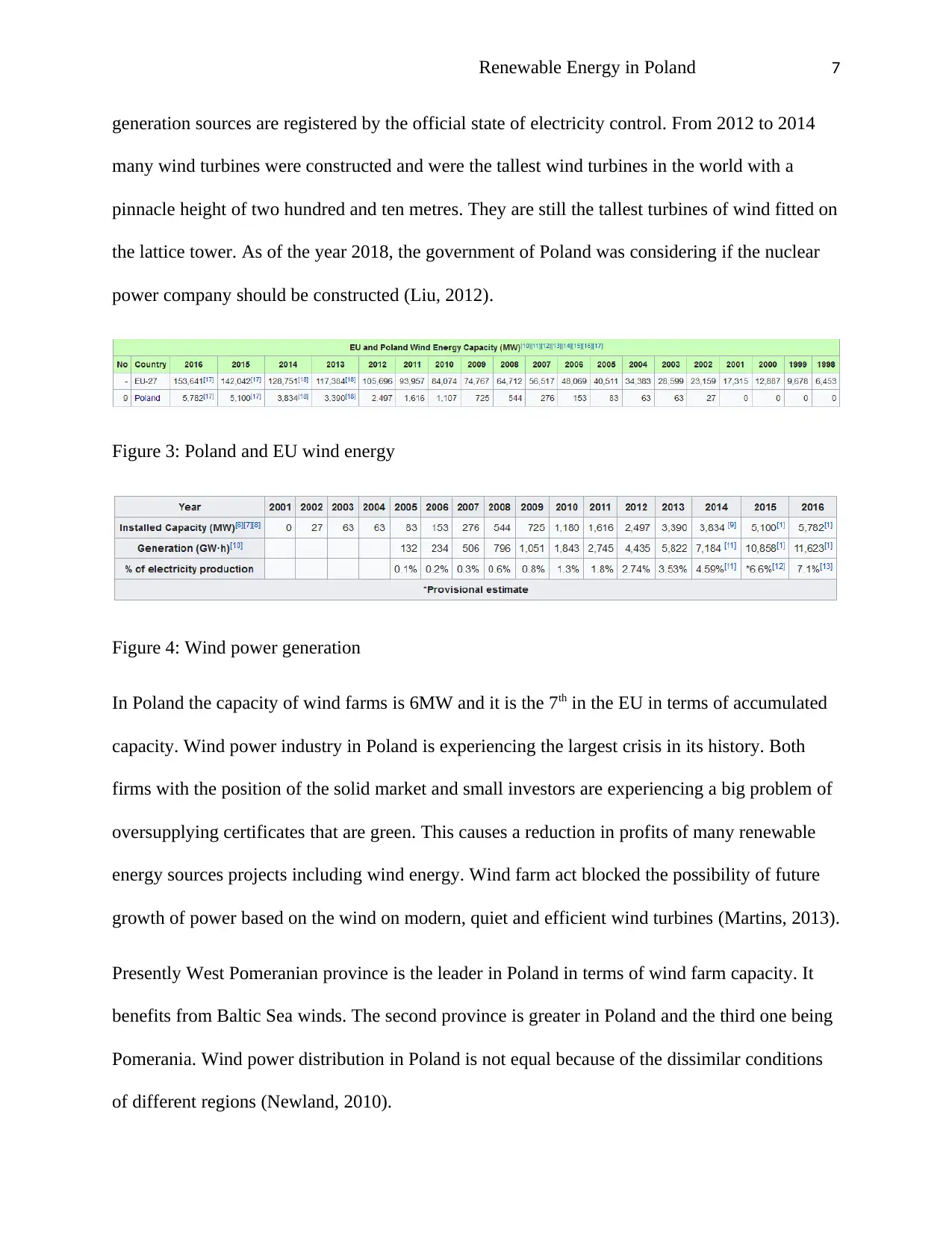
Renewable Energy in Poland 7
generation sources are registered by the official state of electricity control. From 2012 to 2014
many wind turbines were constructed and were the tallest wind turbines in the world with a
pinnacle height of two hundred and ten metres. They are still the tallest turbines of wind fitted on
the lattice tower. As of the year 2018, the government of Poland was considering if the nuclear
power company should be constructed (Liu, 2012).
Figure 3: Poland and EU wind energy
Figure 4: Wind power generation
In Poland the capacity of wind farms is 6MW and it is the 7th in the EU in terms of accumulated
capacity. Wind power industry in Poland is experiencing the largest crisis in its history. Both
firms with the position of the solid market and small investors are experiencing a big problem of
oversupplying certificates that are green. This causes a reduction in profits of many renewable
energy sources projects including wind energy. Wind farm act blocked the possibility of future
growth of power based on the wind on modern, quiet and efficient wind turbines (Martins, 2013).
Presently West Pomeranian province is the leader in Poland in terms of wind farm capacity. It
benefits from Baltic Sea winds. The second province is greater in Poland and the third one being
Pomerania. Wind power distribution in Poland is not equal because of the dissimilar conditions
of different regions (Newland, 2010).
generation sources are registered by the official state of electricity control. From 2012 to 2014
many wind turbines were constructed and were the tallest wind turbines in the world with a
pinnacle height of two hundred and ten metres. They are still the tallest turbines of wind fitted on
the lattice tower. As of the year 2018, the government of Poland was considering if the nuclear
power company should be constructed (Liu, 2012).
Figure 3: Poland and EU wind energy
Figure 4: Wind power generation
In Poland the capacity of wind farms is 6MW and it is the 7th in the EU in terms of accumulated
capacity. Wind power industry in Poland is experiencing the largest crisis in its history. Both
firms with the position of the solid market and small investors are experiencing a big problem of
oversupplying certificates that are green. This causes a reduction in profits of many renewable
energy sources projects including wind energy. Wind farm act blocked the possibility of future
growth of power based on the wind on modern, quiet and efficient wind turbines (Martins, 2013).
Presently West Pomeranian province is the leader in Poland in terms of wind farm capacity. It
benefits from Baltic Sea winds. The second province is greater in Poland and the third one being
Pomerania. Wind power distribution in Poland is not equal because of the dissimilar conditions
of different regions (Newland, 2010).
Paraphrase This Document
Need a fresh take? Get an instant paraphrase of this document with our AI Paraphraser
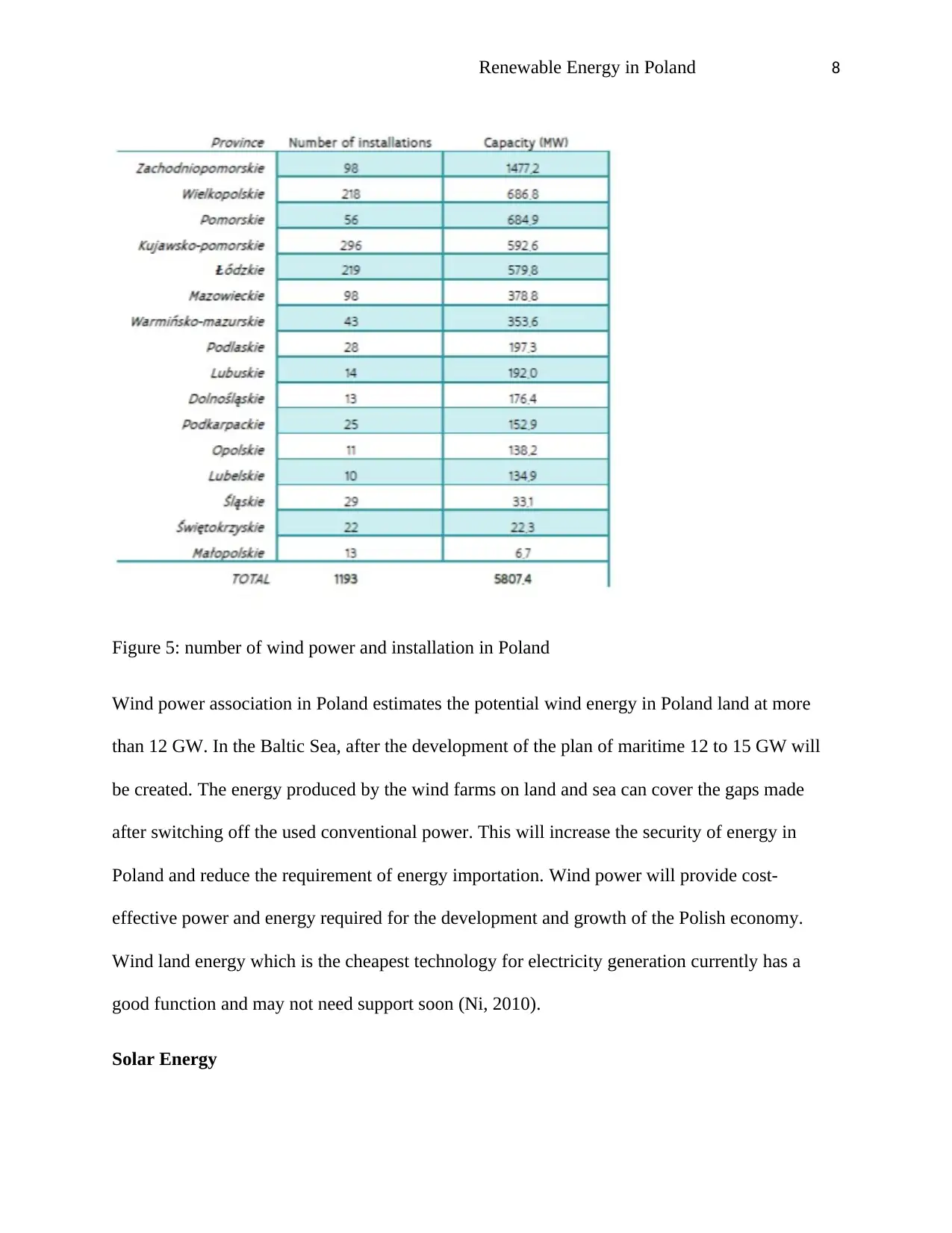
Renewable Energy in Poland 8
Figure 5: number of wind power and installation in Poland
Wind power association in Poland estimates the potential wind energy in Poland land at more
than 12 GW. In the Baltic Sea, after the development of the plan of maritime 12 to 15 GW will
be created. The energy produced by the wind farms on land and sea can cover the gaps made
after switching off the used conventional power. This will increase the security of energy in
Poland and reduce the requirement of energy importation. Wind power will provide cost-
effective power and energy required for the development and growth of the Polish economy.
Wind land energy which is the cheapest technology for electricity generation currently has a
good function and may not need support soon (Ni, 2010).
Solar Energy
Figure 5: number of wind power and installation in Poland
Wind power association in Poland estimates the potential wind energy in Poland land at more
than 12 GW. In the Baltic Sea, after the development of the plan of maritime 12 to 15 GW will
be created. The energy produced by the wind farms on land and sea can cover the gaps made
after switching off the used conventional power. This will increase the security of energy in
Poland and reduce the requirement of energy importation. Wind power will provide cost-
effective power and energy required for the development and growth of the Polish economy.
Wind land energy which is the cheapest technology for electricity generation currently has a
good function and may not need support soon (Ni, 2010).
Solar Energy
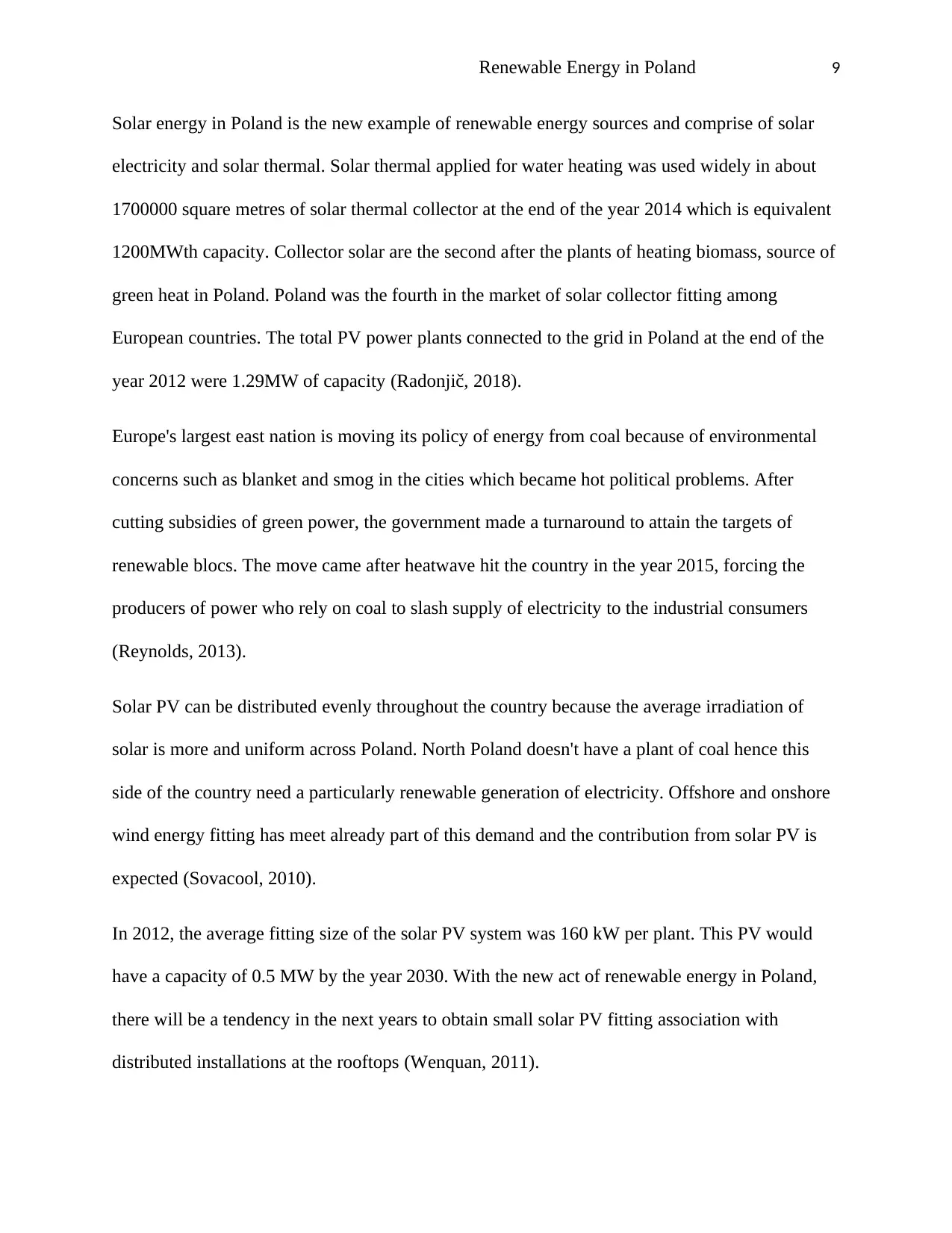
Renewable Energy in Poland 9
Solar energy in Poland is the new example of renewable energy sources and comprise of solar
electricity and solar thermal. Solar thermal applied for water heating was used widely in about
1700000 square metres of solar thermal collector at the end of the year 2014 which is equivalent
1200MWth capacity. Collector solar are the second after the plants of heating biomass, source of
green heat in Poland. Poland was the fourth in the market of solar collector fitting among
European countries. The total PV power plants connected to the grid in Poland at the end of the
year 2012 were 1.29MW of capacity (Radonjič, 2018).
Europe's largest east nation is moving its policy of energy from coal because of environmental
concerns such as blanket and smog in the cities which became hot political problems. After
cutting subsidies of green power, the government made a turnaround to attain the targets of
renewable blocs. The move came after heatwave hit the country in the year 2015, forcing the
producers of power who rely on coal to slash supply of electricity to the industrial consumers
(Reynolds, 2013).
Solar PV can be distributed evenly throughout the country because the average irradiation of
solar is more and uniform across Poland. North Poland doesn't have a plant of coal hence this
side of the country need a particularly renewable generation of electricity. Offshore and onshore
wind energy fitting has meet already part of this demand and the contribution from solar PV is
expected (Sovacool, 2010).
In 2012, the average fitting size of the solar PV system was 160 kW per plant. This PV would
have a capacity of 0.5 MW by the year 2030. With the new act of renewable energy in Poland,
there will be a tendency in the next years to obtain small solar PV fitting association with
distributed installations at the rooftops (Wenquan, 2011).
Solar energy in Poland is the new example of renewable energy sources and comprise of solar
electricity and solar thermal. Solar thermal applied for water heating was used widely in about
1700000 square metres of solar thermal collector at the end of the year 2014 which is equivalent
1200MWth capacity. Collector solar are the second after the plants of heating biomass, source of
green heat in Poland. Poland was the fourth in the market of solar collector fitting among
European countries. The total PV power plants connected to the grid in Poland at the end of the
year 2012 were 1.29MW of capacity (Radonjič, 2018).
Europe's largest east nation is moving its policy of energy from coal because of environmental
concerns such as blanket and smog in the cities which became hot political problems. After
cutting subsidies of green power, the government made a turnaround to attain the targets of
renewable blocs. The move came after heatwave hit the country in the year 2015, forcing the
producers of power who rely on coal to slash supply of electricity to the industrial consumers
(Reynolds, 2013).
Solar PV can be distributed evenly throughout the country because the average irradiation of
solar is more and uniform across Poland. North Poland doesn't have a plant of coal hence this
side of the country need a particularly renewable generation of electricity. Offshore and onshore
wind energy fitting has meet already part of this demand and the contribution from solar PV is
expected (Sovacool, 2010).
In 2012, the average fitting size of the solar PV system was 160 kW per plant. This PV would
have a capacity of 0.5 MW by the year 2030. With the new act of renewable energy in Poland,
there will be a tendency in the next years to obtain small solar PV fitting association with
distributed installations at the rooftops (Wenquan, 2011).
⊘ This is a preview!⊘
Do you want full access?
Subscribe today to unlock all pages.

Trusted by 1+ million students worldwide
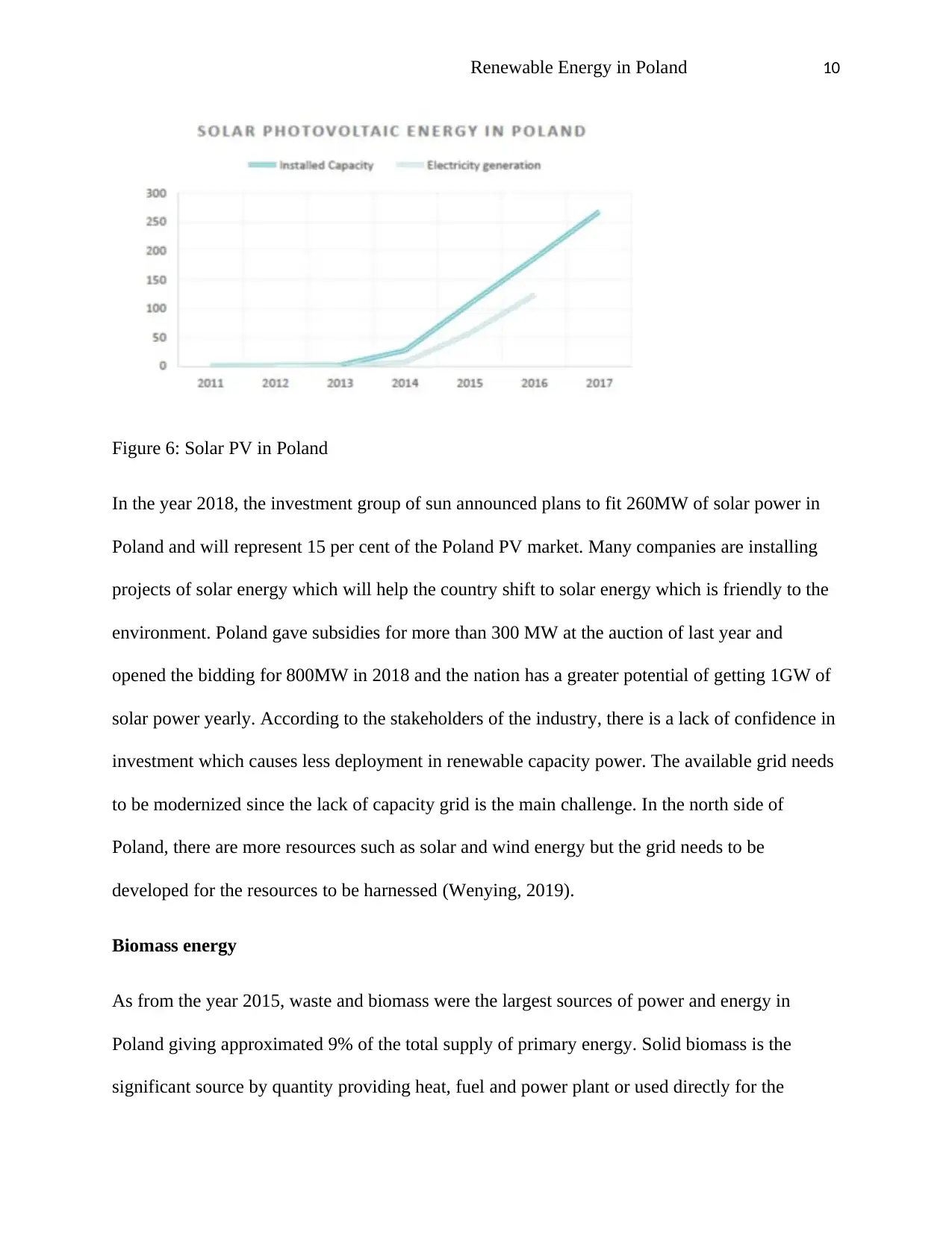
Renewable Energy in Poland 10
Figure 6: Solar PV in Poland
In the year 2018, the investment group of sun announced plans to fit 260MW of solar power in
Poland and will represent 15 per cent of the Poland PV market. Many companies are installing
projects of solar energy which will help the country shift to solar energy which is friendly to the
environment. Poland gave subsidies for more than 300 MW at the auction of last year and
opened the bidding for 800MW in 2018 and the nation has a greater potential of getting 1GW of
solar power yearly. According to the stakeholders of the industry, there is a lack of confidence in
investment which causes less deployment in renewable capacity power. The available grid needs
to be modernized since the lack of capacity grid is the main challenge. In the north side of
Poland, there are more resources such as solar and wind energy but the grid needs to be
developed for the resources to be harnessed (Wenying, 2019).
Biomass energy
As from the year 2015, waste and biomass were the largest sources of power and energy in
Poland giving approximated 9% of the total supply of primary energy. Solid biomass is the
significant source by quantity providing heat, fuel and power plant or used directly for the
Figure 6: Solar PV in Poland
In the year 2018, the investment group of sun announced plans to fit 260MW of solar power in
Poland and will represent 15 per cent of the Poland PV market. Many companies are installing
projects of solar energy which will help the country shift to solar energy which is friendly to the
environment. Poland gave subsidies for more than 300 MW at the auction of last year and
opened the bidding for 800MW in 2018 and the nation has a greater potential of getting 1GW of
solar power yearly. According to the stakeholders of the industry, there is a lack of confidence in
investment which causes less deployment in renewable capacity power. The available grid needs
to be modernized since the lack of capacity grid is the main challenge. In the north side of
Poland, there are more resources such as solar and wind energy but the grid needs to be
developed for the resources to be harnessed (Wenying, 2019).
Biomass energy
As from the year 2015, waste and biomass were the largest sources of power and energy in
Poland giving approximated 9% of the total supply of primary energy. Solid biomass is the
significant source by quantity providing heat, fuel and power plant or used directly for the
Paraphrase This Document
Need a fresh take? Get an instant paraphrase of this document with our AI Paraphraser
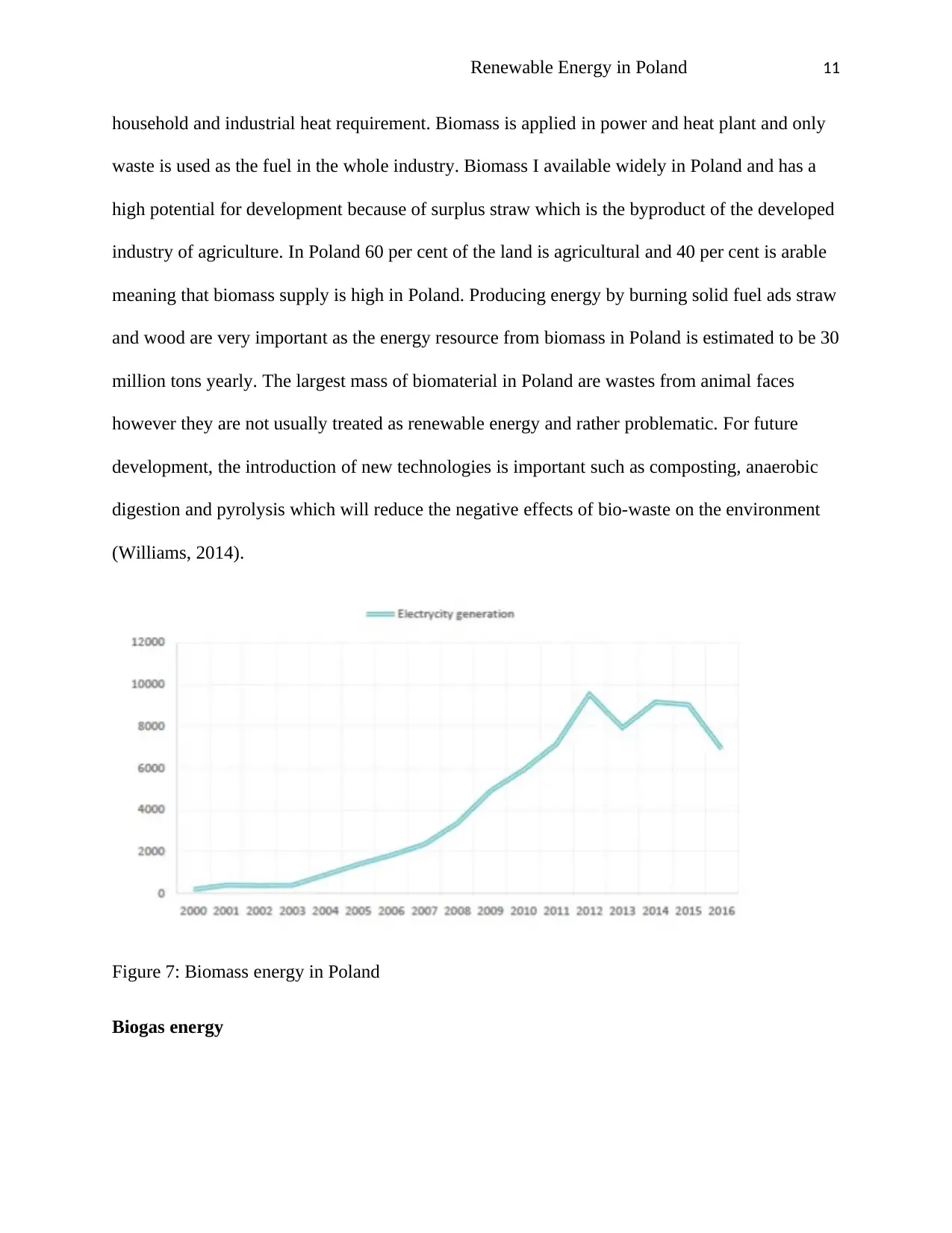
Renewable Energy in Poland 11
household and industrial heat requirement. Biomass is applied in power and heat plant and only
waste is used as the fuel in the whole industry. Biomass I available widely in Poland and has a
high potential for development because of surplus straw which is the byproduct of the developed
industry of agriculture. In Poland 60 per cent of the land is agricultural and 40 per cent is arable
meaning that biomass supply is high in Poland. Producing energy by burning solid fuel ads straw
and wood are very important as the energy resource from biomass in Poland is estimated to be 30
million tons yearly. The largest mass of biomaterial in Poland are wastes from animal faces
however they are not usually treated as renewable energy and rather problematic. For future
development, the introduction of new technologies is important such as composting, anaerobic
digestion and pyrolysis which will reduce the negative effects of bio-waste on the environment
(Williams, 2014).
Figure 7: Biomass energy in Poland
Biogas energy
household and industrial heat requirement. Biomass is applied in power and heat plant and only
waste is used as the fuel in the whole industry. Biomass I available widely in Poland and has a
high potential for development because of surplus straw which is the byproduct of the developed
industry of agriculture. In Poland 60 per cent of the land is agricultural and 40 per cent is arable
meaning that biomass supply is high in Poland. Producing energy by burning solid fuel ads straw
and wood are very important as the energy resource from biomass in Poland is estimated to be 30
million tons yearly. The largest mass of biomaterial in Poland are wastes from animal faces
however they are not usually treated as renewable energy and rather problematic. For future
development, the introduction of new technologies is important such as composting, anaerobic
digestion and pyrolysis which will reduce the negative effects of bio-waste on the environment
(Williams, 2014).
Figure 7: Biomass energy in Poland
Biogas energy
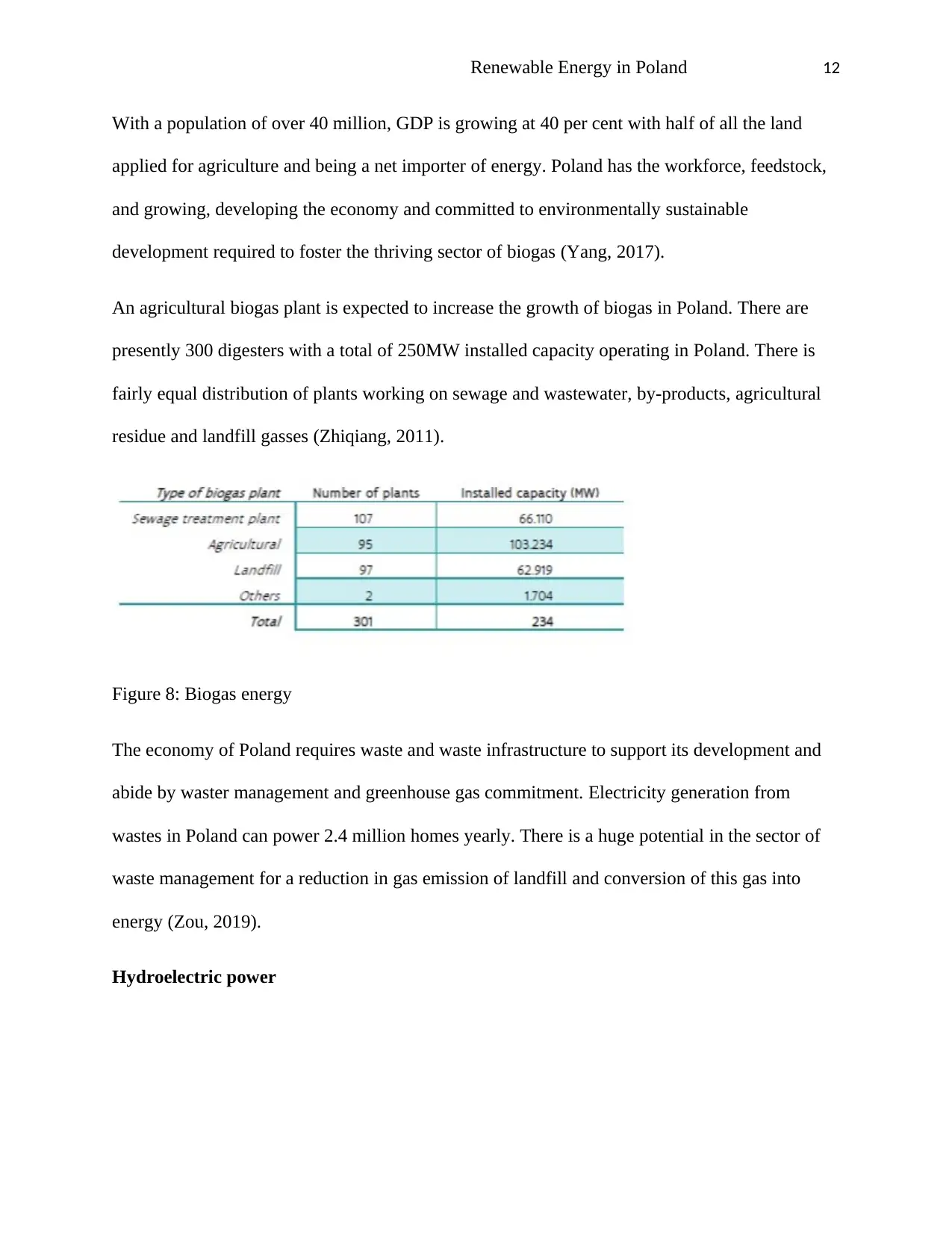
Renewable Energy in Poland 12
With a population of over 40 million, GDP is growing at 40 per cent with half of all the land
applied for agriculture and being a net importer of energy. Poland has the workforce, feedstock,
and growing, developing the economy and committed to environmentally sustainable
development required to foster the thriving sector of biogas (Yang, 2017).
An agricultural biogas plant is expected to increase the growth of biogas in Poland. There are
presently 300 digesters with a total of 250MW installed capacity operating in Poland. There is
fairly equal distribution of plants working on sewage and wastewater, by-products, agricultural
residue and landfill gasses (Zhiqiang, 2011).
Figure 8: Biogas energy
The economy of Poland requires waste and waste infrastructure to support its development and
abide by waster management and greenhouse gas commitment. Electricity generation from
wastes in Poland can power 2.4 million homes yearly. There is a huge potential in the sector of
waste management for a reduction in gas emission of landfill and conversion of this gas into
energy (Zou, 2019).
Hydroelectric power
With a population of over 40 million, GDP is growing at 40 per cent with half of all the land
applied for agriculture and being a net importer of energy. Poland has the workforce, feedstock,
and growing, developing the economy and committed to environmentally sustainable
development required to foster the thriving sector of biogas (Yang, 2017).
An agricultural biogas plant is expected to increase the growth of biogas in Poland. There are
presently 300 digesters with a total of 250MW installed capacity operating in Poland. There is
fairly equal distribution of plants working on sewage and wastewater, by-products, agricultural
residue and landfill gasses (Zhiqiang, 2011).
Figure 8: Biogas energy
The economy of Poland requires waste and waste infrastructure to support its development and
abide by waster management and greenhouse gas commitment. Electricity generation from
wastes in Poland can power 2.4 million homes yearly. There is a huge potential in the sector of
waste management for a reduction in gas emission of landfill and conversion of this gas into
energy (Zou, 2019).
Hydroelectric power
⊘ This is a preview!⊘
Do you want full access?
Subscribe today to unlock all pages.

Trusted by 1+ million students worldwide
1 out of 18
Related Documents
Your All-in-One AI-Powered Toolkit for Academic Success.
+13062052269
info@desklib.com
Available 24*7 on WhatsApp / Email
![[object Object]](/_next/static/media/star-bottom.7253800d.svg)
Unlock your academic potential
Copyright © 2020–2025 A2Z Services. All Rights Reserved. Developed and managed by ZUCOL.





